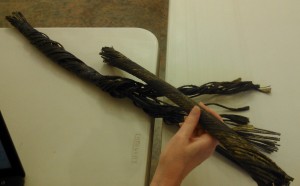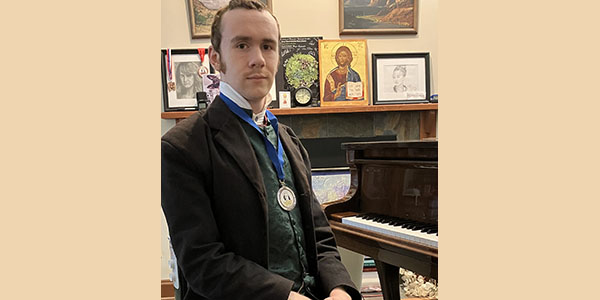— by Lin McNulty and Margie Doyle —
CenturyLink Regional President Brian Stading took center stage at a public forum on Thursday, November 14, at the Orcas Senior Center, backed up by a team of nine other technical and public relations personnel. Orcas residents brought their questions, their concerns, their irritation, and their compassion to this meeting in a desire to hear answers, as well as to be heard.
“Clearly,” said Stading, “this is a difficult time.”
The fiber damage and phone outage was initially discovered by CenturyLink on Tuesday, November 5 at 4:53 a.m. when they stopped seeing a signal from the fiber. It was reported in Orcas Issues on November 11 by CenturyTel that they believed the damage was caused by a couple of small magnitude earthquakes 8 km NNW of Friday Harbor at 9:40 p.m. on Monday, November 4, and/or another one 23 km WNW of Forks, WA at 6:52 a.m. on Tuesday, November 5. The second quake occurred, however, after the outage. The cause has since been revised to “unknown.”
“We don’t believe we will ever know what happened,” stated Stading. “There is no evidence of anchor drag. We can only determine something happened; they just don’t break on their own.” The severed cable was brand new in 1999. Although Stading claimed this one cable has more capability than the islands would ever need, many expressed concerns about the lack of redundancy.
After waiting for a projector from OIFR, photos of ongoing site work were shown on a screen behind Stading, but no explanation or clarification was offered about what was being seen in the slideshow.
To their credit, CenturyLink put together some inventive and ingenious fixes to get services restored; 911 service to all islands was restored within two and a half days. At press time, however, 911 service on Lopez is once again spotty and not completely reliable. Switch issues also continue to intermittently impact Orcas and Lopez phone service as additional capacity is spliced in.
During the 911 outage on Orcas, Lopez, and Shaw, local agencies, such as Orcas Fire and Rescue, put emergency protocols into place, and advised local residents as quickly as possible that calls for police, fire, and medical emergencies were to be routed through the fire department business lines where volunteers were on duty to receive calls; radio communication with the Sheriff’s Office dispatchers was (and remains) available.
CenturyLink needed to find 6,000 feet of cable and reached out across the globe to locate the equipment. The necessary cable was available in Norway, Sweden, Brazil, and—luckily— in Kent, Washington. When they needed a specialized fiber splicing case, they found one available in Spain, but determined it would be quicker to actually build one.
Divers required a special gas mixture that is only available in California in order to be able to go to the necessary depths. As the divers return to the surface, they must spend a couple of hours at a depth of 200 feet before surfacing. Once back on the barge they then have three minutes to enter one of two hyperbaric chambers on board.
They built a mobile manufacturing facility in 36 hours. Normally, it takes two-three months. Because the severed cable lay close to OPALCO power cable, extra care was taken to not damage OPALCO lines. Eventually three tugboats were brought to the site to stabilize the remote operating vehicle (ROV).
Thirty-five people at any one time have been working around the clock, along with OPALCO (as we are well aware), to fully restore service. “We are not taking this lightly. We are working on getting redundancy built in,” Stading stressed.
Until last week, there was no plan for this type of failure. “Once we get this restoration up and running,” assured Stading, “this will all be reviewed to build in redundancy, looking at what is available on island as well as off island.”
Stading acknowledged there have been lots of rumors and miscommunications, but that CenturyLink remains dedicated to “not saying” something that isn’t fundamentally accurate.
Foremost in most attendees’ minds was how CenturyLink will reimburse for losses. That will be looked at,” said Stading, “and CenturyLink will do the fair and right thing.” This is not their first outage and they have experience with those taking advantage of a situation to receive compensation. The community is to be assured that CenturyLink will pro-actively pursue compensation, although any adjustment might not show up on the next bill, as they are still working on the immediate problem. It was not clear how the process might unfold, whether each customer will need to pursue compensation, or whether it will automatic.
Is it correct to say that everything eventually goes through CenturyLink? Not everything, but a good majority of all our data and voice communication does.
Senior Center Director Marla Johns pointed out that a woman lay on floor for three days because her Medical Alert device was unable to dial out. She made sure that CenturyLink realizes this has “impacted health and safety in a way we cannot put a price tag on.”
County Council Member Rick Hughes explained he will be working with all providers over the next few months, putting a lot of pressure on CenturyLink to resolve this and do whatever it takes to make sure this does not happen again. A Press Release will soon be coming from the County with instructions on how to report business losses to the Small Business Administration.
So, is this fully resolved? The simple answer is “no.” Spotty and sporadic outages are still possible in all areas as the interim network becomes overloaded, or new connections are made. They are not able to give a time estimate for complete restoration because of so many variables, including weather, equipment, and currents. The cable is now spliced, but not yet put back into place. Stading “promised” we will be back in full service before Obamacare takes effect (March 2014).
**If you are reading theOrcasonian for free, thank your fellow islanders. If you would like to support theOrcasonian CLICK HERE to set your modestly-priced, voluntary subscription. Otherwise, no worries; we’re happy to share with you.**









Looking to the future, I think the key word here is “redundancy” and we islanders can’t leave that in the hands of outside corporations any more. The best solution will likely be using OPALCO’s fiber backbone and inter-island communications network to provide it.
Thanks, Lin and Margie, for the explanation. As in most disasters, what happens in a moment usually takes much longer to fix. I’m just glad to see that the fixing is being done. Once that’s over and the frustration subsides, we can all figure out how to avoid future “moments”. Thanks again for the article.
“To their credit, CenturyLink put together some inventive and ingenious fixes to get services restored; 911 service to all islands was restored within two and a half days.”
Two points. First, it was my understanding that the “fixes” were as much or more the result of islanders. Second, 2.5 days for restoring 911 service is nothing to crow about. How could there be no backup plan for this, of all the services that rely upon CenturyTel?
This just in from Rock Island:
Good news for Friday!
CenturyLink has repaired the submarine fiber cable, around 10am this morning we were
contacted by CenturyLink engineers to work on shifting the San Juan Island DSL
traffic off our private network back over to the fiber link. That has been
completed and traffic flows appear to be normal.
This event is far from over however, there is still much work to be done to ‘back
out’ temporary fixes to bring up various services (911, dial-tone, Long Distance,
etc) that may continue to cause disruption, both for voice and data services.
I’m glad to see nobody said the cable fail was an “act of God”. An act of God is a tree falling on your cable, a cable break in an underwater environment is crappy engineering.
God doesn’t work underwater?
Seriously, this is great news that the cable is repaired. Century Link, for all of its problems, did a remarkable job getting the repair completed quickly in a very challenging environment.
Please be aware that there was a back-up plan for emergency services on Orcas. The Fire Department initially staffed all stations so that people could walk in with their emergencies, and used local ham radio operators to relay some emergency traffic (which is actually part of their advanced planning, and it worked well). They had dispatchers on Orcas for several days until county-wide service was restored. No emergency work-around is perfect, but I think our people did a great job with outreach, communication, and trying to educate the community about options to 911 service.
The reported fact that a “small earthquake”might have severed the cable could prepare us for what we might need to cope with during a larger one. We need to study the availability of redundant systems.
Backup, backup….good for computers, imperative for communication equipment. No redundancy? No buried cable, to prevent this kind of thing?